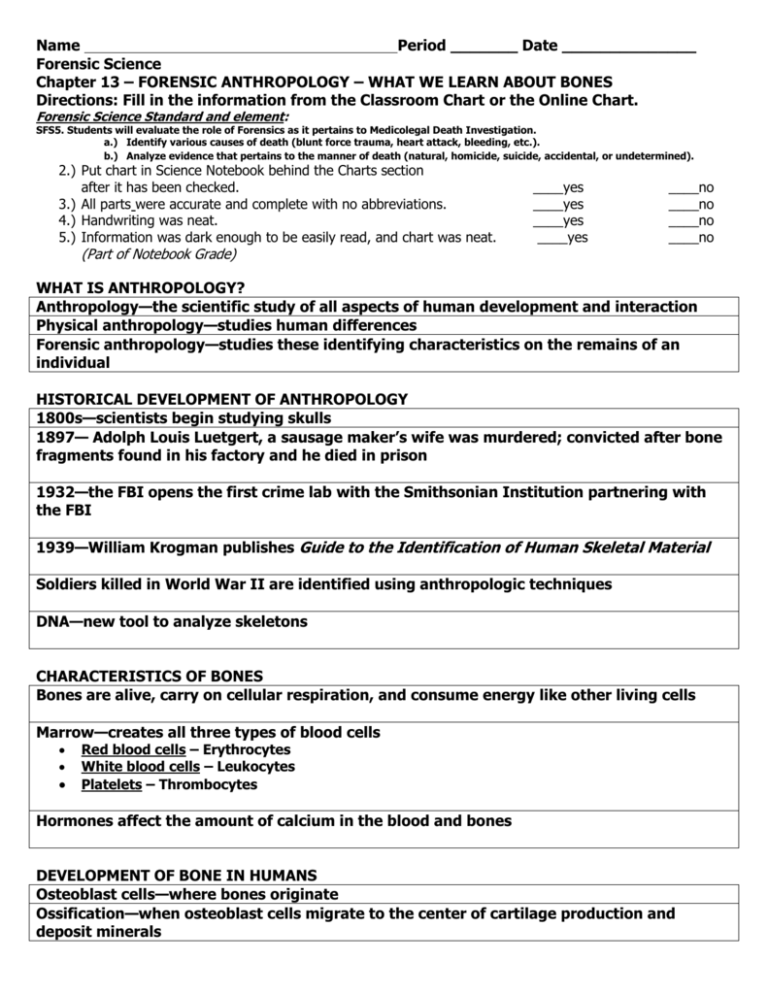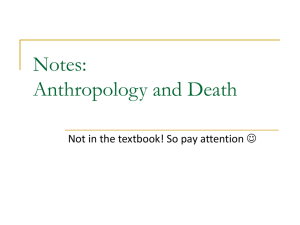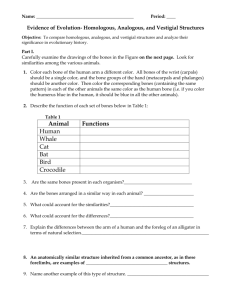CHART: Forensic Anthropology, C.13 TEACHER COPY
advertisement

Name Period _______ Date ______________ Forensic Science Chapter 13 – FORENSIC ANTHROPOLOGY – WHAT WE LEARN ABOUT BONES Directions: Fill in the information from the Classroom Chart or the Online Chart. Forensic Science Standard and element: SFS5. Students will evaluate the role of Forensics as it pertains to Medicolegal Death Investigation. a.) Identify various causes of death (blunt force trauma, heart attack, bleeding, etc.). b.) Analyze evidence that pertains to the manner of death (natural, homicide, suicide, accidental, or undetermined). 2.) Put chart in Science Notebook behind the Charts section after it has been checked. 3.) All parts were accurate and complete with no abbreviations. 4.) Handwriting was neat. 5.) Information was dark enough to be easily read, and chart was neat. (Part of Notebook Grade) ____yes ____yes ____yes ____yes ____no ____no ____no ____no WHAT IS ANTHROPOLOGY? Anthropology—the scientific study of all aspects of human development and interaction Physical anthropology—studies human differences Forensic anthropology—studies these identifying characteristics on the remains of an individual HISTORICAL DEVELOPMENT OF ANTHROPOLOGY 1800s—scientists begin studying skulls 1897— Adolph Louis Luetgert, a sausage maker’s wife was murdered; convicted after bone fragments found in his factory and he died in prison 1932—the FBI opens the first crime lab with the Smithsonian Institution partnering with the FBI 1939—William Krogman publishes Guide to the Identification of Human Skeletal Material Soldiers killed in World War II are identified using anthropologic techniques DNA—new tool to analyze skeletons CHARACTERISTICS OF BONES Bones are alive, carry on cellular respiration, and consume energy like other living cells Marrow—creates all three types of blood cells Red blood cells – Erythrocytes White blood cells – Leukocytes Platelets – Thrombocytes Hormones affect the amount of calcium in the blood and bones DEVELOPMENT OF BONE IN HUMANS Osteoblast cells—where bones originate Ossification—when osteoblast cells migrate to the center of cartilage production and deposit minerals Life cycle—bone is deposited, breaks down, and replaced Osteoclasts—the 2nd type of bone cell, specialized to dissolve bone • Specialized to dissolve bone • Allows bones to reshape as they grow • Balances calcium levels in blood • Removes cellular wastes and debris from bones Osteoporosis—a deficiency of calcium in the bones HOW BONES CONNECT cartilage—wraps the ends of bones for protection and prevents scraping ligaments—bands that connect two or more bones together tendons—connect muscle to bone AGING OF BONE Under 30 years of age—bones increase in size Over 30—process reverses Exercise slows deterioration WHAT CAN BONES TELL US Osteobiography – bones contain a record of the physical life Analyzing bones reveals clues to gender, age, height, and health o Examples: • In a right-handed person, right arm bones might be slightly larger than the bones of the left arm • X-rays may identify prior fractures, pins, artificial joints GENDER - SKULL MALE FEMALE MALE CHARACTERISTICS TRAIT FEMALE CHARACTERISTICS More square Shape of eye More rounded More square Mandible shape from underside More V-shaped Thick and larger Upper brow ridge Thin and smaller MALE FEMALE MALE CHARACTERISTICS TRAIT FEMALE CHARACTERISTICS Present Occipital protuberance Absent Low and sloping Frontal bone Higher and more rounded Rough and bumpy Surface of skull Smooth Straight Ramus of mandible Slanting Rough and bumpy Nuchal crest Smooth Male Female The female skull is smoother than the male’s The male frontal bone is lower and sloping and the female's is higher and rounded The male’s eye orbits are squarer with the females more circular The male's lower jaw is square with about a 90o angle and males have square chins The female's lower jaw is sloped with an angle greater than 90o and females usually have rounder or more V-shaped chins Gender – Pelvis o o o o o o o o An easy method to determine gender The surface of a woman’s pelvis can be scarred The sub pubic angle of the female pelvis is greater than 90o; the male’s, less GENDER - THIGH BONES The male femur is thicker and joins the pelvis at a straighter angle than the female femur AGE - SKULL 1.) By about age 30, the suture at the back of the skull closes 2.) By about age 32, the suture running across the top of the skull, back to front, closes 3.) By about age 50, the suture running side to side over the top of the skull, near the front, closes 1.) 2.) 3.) AGE - BIRTH o At birth—450+ bones in the skeleton o Adults— 206 bones o Epiphysis line—appears where cartilage is replaced by bone o When the cartilage is fully replaced, the line is no longer visible o This information can be used to approximate a skeleton’s age AGE - EPIPHYSIS (THE EPIPHYSIS IS THE END OF A LONG BONE THAT INITIALLY GROWS SEPARATELY FROM THE SHAFT.) HEIGHT o An estimate of height can be made by measuring one of the long bones o Gender and race is taken into consideration ESTIMATION OF AGE USING BONES REGION OF THE BODY Arm Leg BONE Humerus bones in the head fused Humerus bones in the head fused to shaft Femur: Greater trochanter first appears (greater trochanter is one of the bony prominences toward the near end of the thighbone (the femur). There are two trochanters) Less trochanter first appears Femur head fused to shaft Condyles join shaft 13-14 16-18 20 Clavicle and sternum close Pubis, ischium and almost completely united 18-24 7-8 Ileum, ischium, and pubic bones fully ossified 20-25 All segments of sacrum united 25-30 Lambdoidal suture close Sagittal suture close Coronal suture close Begins 21 Ends 30 32 50 (condyle is a rounded protrusion at the end of a bone that's designed to help it connect to another bone) Shoulder Pelvis AGE 4-6 18-20 4 (pubis is either of a pair of bones forming the two sides of the pelvis - ischium is curved bone forming the base of each half of the pelvis) (ileum is part of the small intestine - ossified is when the bone is when fibrous tissue becomes bone) (sacrum is a triangular bone in the lower back formed from fused vertebrae and situated between the two hipbones of the pelvis) Skull HOW TO DISTINGUISH RACE o Shape of the eye sockets o Absence or presence of a nasal spine o Measurements of the nasal index o Prognathism o Width of the face o Angulation of the jaw and face FACIAL RECONSTRUCTION o Facial muscles follow the contour of the skull o A face can be rebuilt from just skeletal remains • Facial markers are positioned at critical locations • Clay is contoured to follow the height of the markers o Computer programs perform a similar function o Computer programs also can “age” missing persons and criminals DNA EVIDENCE o Bone contains little nuclear DNA but it does contain mitochondrial DNA o Nuclear DNA degenerates before mitochondrial DNA o Mitochondrial DNA is inherited only from the mother o Compare results with living relatives on the mother’s side of the family SKELATAL TRAUMA ANALYSIS o Forensic anthropologists determine if damage to bones occurred before or after death o Distinct patterns exist for damage by • • • • • Environment Sharp-force trauma Blunt-force trauma Gunshot wounds Knife wounds









